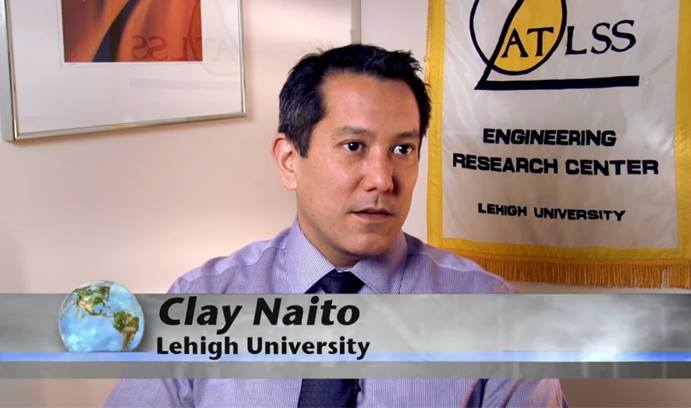Structural engineer measures impact of tsunami debris

In a lab at Lehigh’s Advanced Technology for Large Structural Systems (ATLSS) Engineering Research Center, civil and environmental engineering professor Clay Naito is measuring the impact of debris strikes with tests involving a telephone pole and a shipping container.
This week marks 50 years since the Great Alaska Earthquake and Tsunami of 1964 – the largest and most destructive recorded tsunami to ever strike the Pacific Coast – as well as National Tsunami Preparedness Week in the U.S.
Since the Alaska tsunami, strides have been made in research related to tsunami destruction. Until recently, however, engineers could only estimate the forces at work when debris struck a home or a similar structure during a tsunami.
In a lab at Lehigh’s Advanced Technology for Large Structural Systems (ATLSS) Engineering Research Center, civil and environmental engineering professor Clay Naito is measuring the impact of debris strikes with tests involving a telephone pole and a shipping container. His work is part of a larger effort by engineers across the country, with support from the National Science Foundation (NSF), to design and carry out a series of large-scale tests aimed at better understanding what happens when debris strikes.
“The research project is essentially looking at the types of debris that would be in a typical tsunami environment, and what forces are being generated by that debris,” Naito said. “The general understanding gained from these models allows the team to determine building design loads for impact by various debris types, based on their impact velocity, mass and stiffness. These data allow one to examine the response of buildings, and provides engineers with the information needed to design for an accidental impact.
Naito’s work was featured in the following video report created by NSF and shared by The Weather Channel and other news outlets.
Since the Alaska tsunami, strides have been made in research related to tsunami destruction. Until recently, however, engineers could only estimate the forces at work when debris struck a home or a similar structure during a tsunami.
In a lab at Lehigh’s Advanced Technology for Large Structural Systems (ATLSS) Engineering Research Center, civil and environmental engineering professor Clay Naito is measuring the impact of debris strikes with tests involving a telephone pole and a shipping container. His work is part of a larger effort by engineers across the country, with support from the National Science Foundation (NSF), to design and carry out a series of large-scale tests aimed at better understanding what happens when debris strikes.
“The research project is essentially looking at the types of debris that would be in a typical tsunami environment, and what forces are being generated by that debris,” Naito said. “The general understanding gained from these models allows the team to determine building design loads for impact by various debris types, based on their impact velocity, mass and stiffness. These data allow one to examine the response of buildings, and provides engineers with the information needed to design for an accidental impact.
Naito’s work was featured in the following video report created by NSF and shared by The Weather Channel and other news outlets.
Posted on:
Wednesday, March 26, 2014

